
03/27/2024 by Christine Morris
Flatbed Trailers: Which One Should You Use for Your Freight?
Whether it’s lumber, piping, hay, palletized goods, or construction supplies, flatbed trailers, also known as open-deck trailers, can handle it all. Flatbed trailers are extremely versatile in their use, but that’s because, unlike enclosed trailers, there are many variations of flatbeds to choose from. If you’re considering a flatbed or open-deck trailer for your shipment, how do you know which one is best for your freight? This article will help you answer just that. Read on to better understand the different kinds of flatbed trailers that are available so you can make an informed decision on which one your freight needs.
Types of Flatbed Trailers
Flatbed trailers come in all shapes, sizes, and load capacities; each designed to carry different types of cargo. The one tricky part of flatbed shipping is choosing and finding the flatbed trailer that is capable of hauling your freight’s weight and size. It’s also important to note that anything exceeding legal dimensions and weight can be considered oversized and may require more to ship, such as state permits, police, escorts, or more.
Shipping oversized? Download our FREE Over-Dimensional Shipping Guide.*Important Note – Trailer capacity, weight, and dimensions mentioned in this article are general specifications and should be used as an estimated guideline. These can vary based on the trailer type, brand, or semi-tractor being used with it.
- Standard flatbed
- Extendable flatbed
- Step deck / drop deck
- Stretch single step deck / drop deck
- Double drop
- Stretch / extendable double drop
- Removable gooseneck (RGN)
- Stretch RGN
- Conestoga
- Side kit
Standard Flatbed Trailers
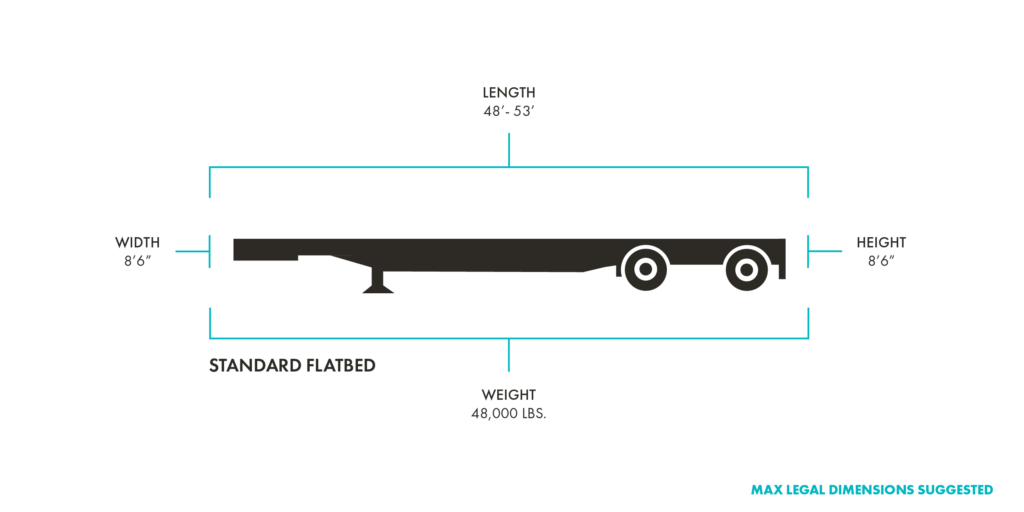
Maximum Legal Weight: 48,000 lbs.
Maximum Legal Cargo Length: 48 to 53 ft.
Maximum Legal Width: 8 ft. 6 in.
Maximum Legal Height: 8 ft. 6 in.
Standard flatbed trailers are widely used and versatile, often the most popular of all flatbed trailers. They most commonly haul steel, lumber, and other kinds of building or construction materials.
Extendable Flatbed Trailers
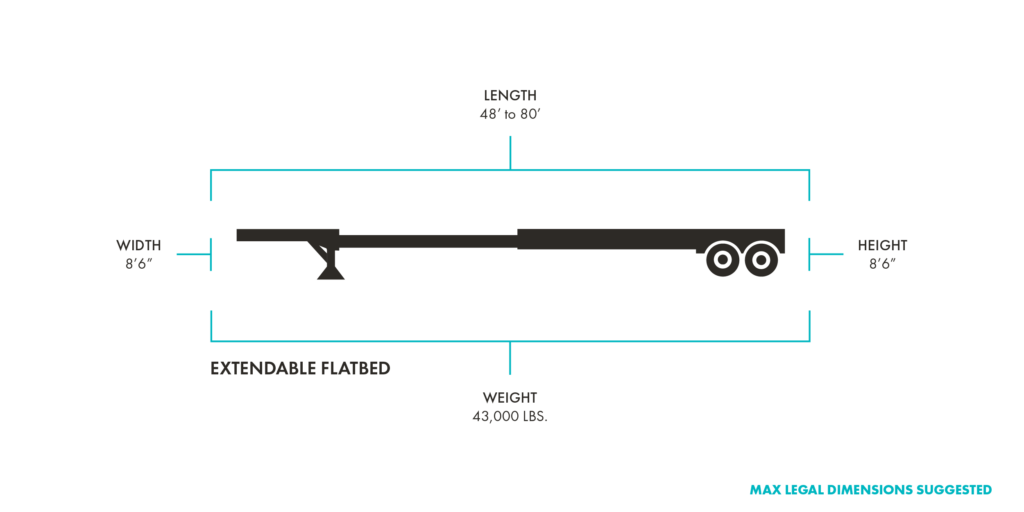
Maximum Legal Weight: 43,000 lbs.
Maximum Legal Cargo Length: 48 to 80 ft.
Maximum Legal Width: 8 ft. 6 in.
Maximum Legal Height: 8 ft. 6 in.
Extendable flatbed trailers can also be known as flatbed stretch trailers. These trailers have an extendable deck to transport cargo that is too long for a standard flatbed, like a piece of large or heavy machinery.
Step Deck/ Drop Deck Flatbed Trailers
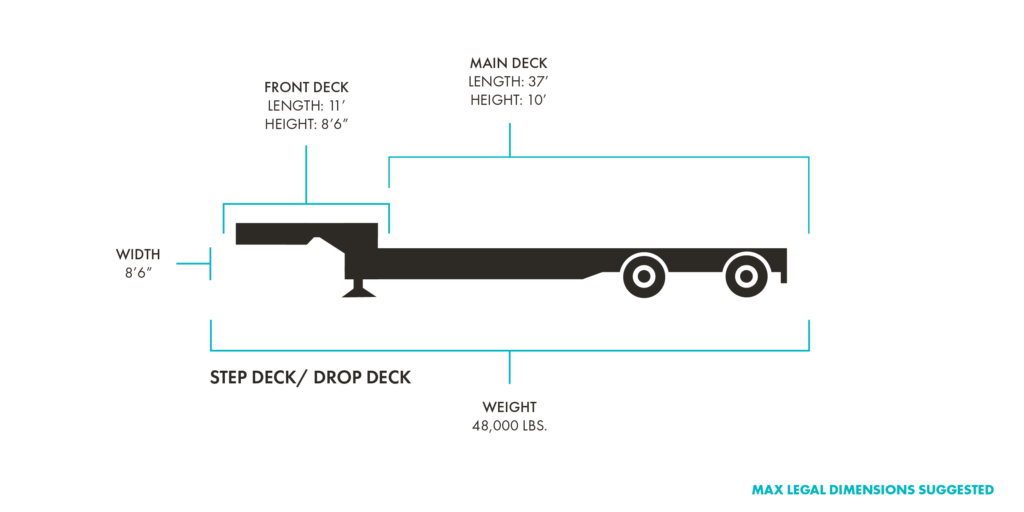
Maximum Legal Weight: 48,000 lbs.
Top Deck: Maximum Legal Cargo Length: 11 ft.
Bottom Deck: Maximum Legal Cargo Length: 37 ft.
Maximum Legal Width: 8 ft. 6 in.
Maximum Legal Height: 10 ft. on the bottom deck, 8 ft 6 in. on the top deck
These trailers are referred to as either a step deck or a drop deck. They consist of a bottom deck and a top deck. These flatbed trailers are great for transporting freight that would exceed the height restriction on a standard flatbed; they are ideal for any tall loads that need to go under low bridges. They also make it easy to use ramps to load and unload freight. A common piece of freight they haul is tractors.
Stretch Single Step Deck/Drop Deck Flatbed Trailers
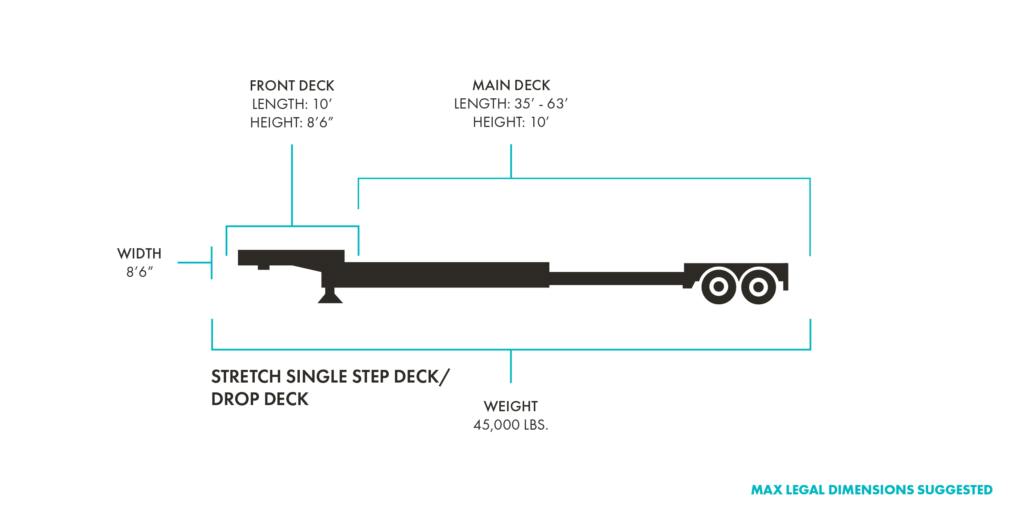
Maximum Legal Weight: 45,000 lbs.
Front Deck: Maximum Legal Cargo Length: 10 ft.
Main Deck: Maximum Legal Cargo Length: 35 to 63 ft.
Maximum Legal Width: 8 ft. 6 in.
Front Deck: Maximum Legal Height: 8 ft. 6 in.
Main Deck: Maximum Legal Height: 10 ft.
These flatbed trailers are like step decks, except they can be extended to transport cargo that can be too long for a standard step deck. This can include goods like scaffolding or drilling and mining equipment.
Double Drop Flatbed Trailers
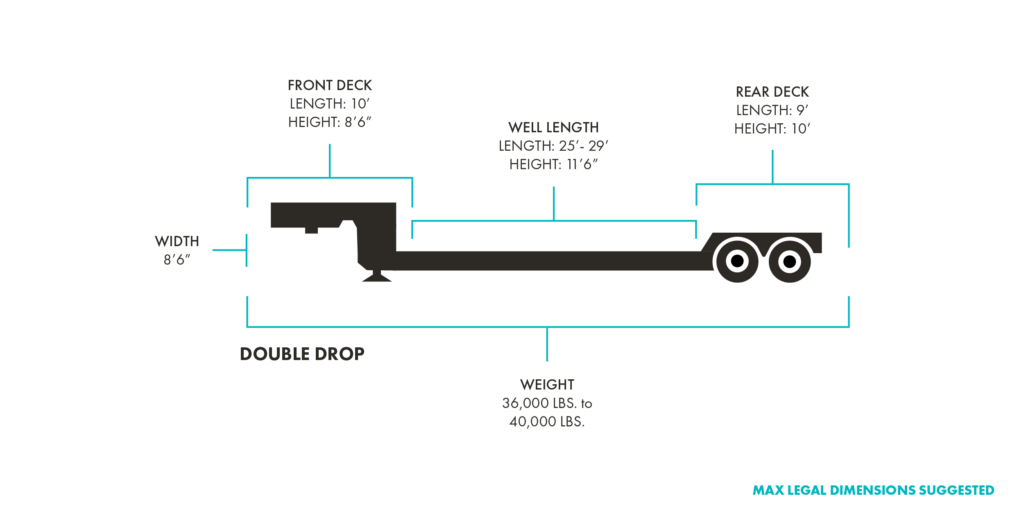
Maximum Legal Weight: 36,000 to 40,000 lbs.
Front Deck: Maximum Legal Cargo Length: 10 ft.
Main Deck (well): Maximum Legal Cargo Length: 25 to 29 ft.
Rear Deck: Maximum Legal Cargo Length: 9 ft.
Maximum Legal Width: 8 ft. 6 in.
Front Deck: Maximum Legal Height: 8 ft. 6 in.
Main Deck (well): Maximum Legal Height: 11 ft. 6 in.
Rear Deck: Maximum Legal Height: 10 ft.
Double drop trailers are also good for cargo that is too tall and generally used to haul oversized freight. Double drop trailers are unique in that they have a longer piece of the trailer called the “well”.
Stretch/Extendable Double Drop Flatbed Trailers
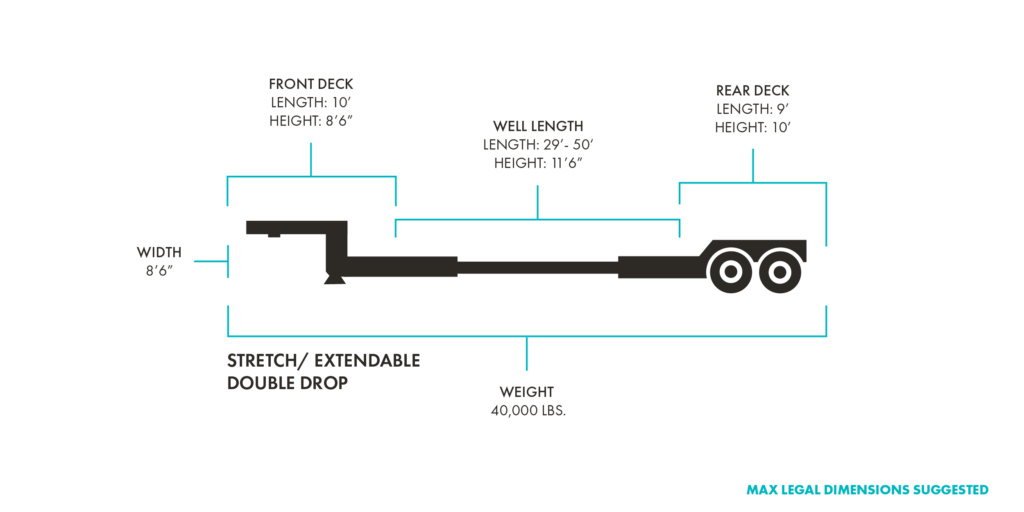
Maximum Legal Weight: 40,000 lbs.
Front Deck: Maximum Legal Cargo Length: 10 ft.
Main Deck (well): Maximum Legal Cargo Length: 29 to 50 ft.
Rear Deck: Maximum Legal Cargo Length: 9 ft.
Maximum Legal Width: 8 ft. 6 in.
Front Deck: Maximum Legal Height: 8 ft. 6 in.
Main Deck (well): Maximum Legal Height: 11 ft. 6 in.
Rear Deck: Maximum Legal Height: 10 ft.
Like the standard double drop trailer, this one is also great for oversized freight. Since this trailer can be lengthened for longer loads, it’s ideal to carrier longer freight since it provides more support and prevents any overhang. It’s also common for this trailer to have two to three axles so it can support more weight. Common freight hauled by stretch double drops are pipes and steel beams.
Removable Gooseneck (RGN) Flatbed Trailers
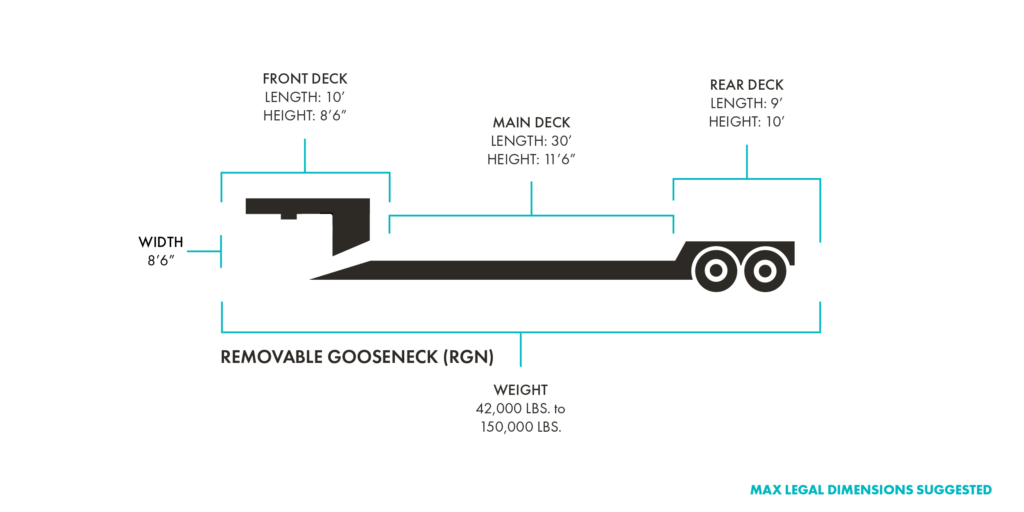
Maximum Legal Weight: 42,000 to 150,000 lbs.
Front Deck: Maximum Legal Cargo Length: 10 ft.
Main Deck: Maximum Legal Cargo Length: 30 ft.
Rear Deck: Maximum Legal Cargo Length: 9 ft.
Maximum Legal Width: 8 ft. 6 in.
Front Deck: Maximum Legal Height: 8 ft. 6 in.
Main Deck (well): Maximum Legal Height: 11 ft. 6 in.
Rear Deck: Maximum Legal Height: 10 ft.
An RGN is one special flatbed trailer. They’re great for long, tall, and heavy freight! They have a detachable front that can be used to create a ramp for loading and unloading and can expand from three axles to over 20, to carry heavy items, like farming combines. However, it’s important to note that since these are more specialized, they can be tougher to find and more expensive to use for your flatbed shipping.
Stretch RGN Flatbed Trailers
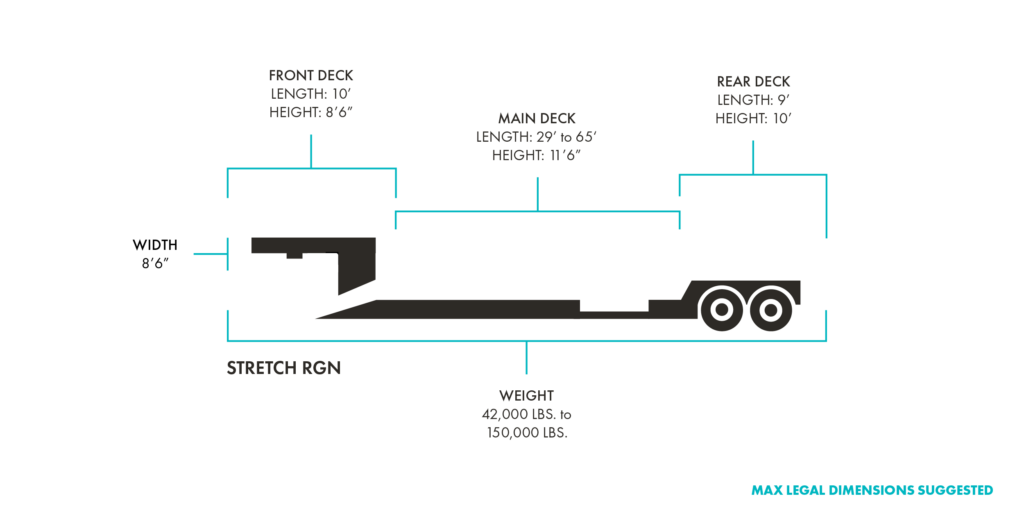
Maximum Legal Weight: 42,000 to 150,000 lbs.
Front Deck: Maximum Legal Cargo Length: 10 ft.
Main Deck: Maximum Legal Cargo Length: 29 to 65 ft.
Rear Deck: Maximum Legal Cargo Length: 9 ft.
Maximum Legal Width: 8 ft. 6 in.
Front Deck: Maximum Legal Height: 8 ft. 6 in.
Main Deck (well): Maximum Legal Height: 11 ft. 6 in.
Rear Deck: Maximum Legal Height: 10 ft.
When you need an RGN that can haul longer freight, a stretch or extendable RGN can help. Just like the standard RGN, axles can vary, from three and up, depending on the freight weight. The only real difference with this RGN trailer is the main deck is extendable up to 65 feet long.
Conestoga Flatbed Trailers
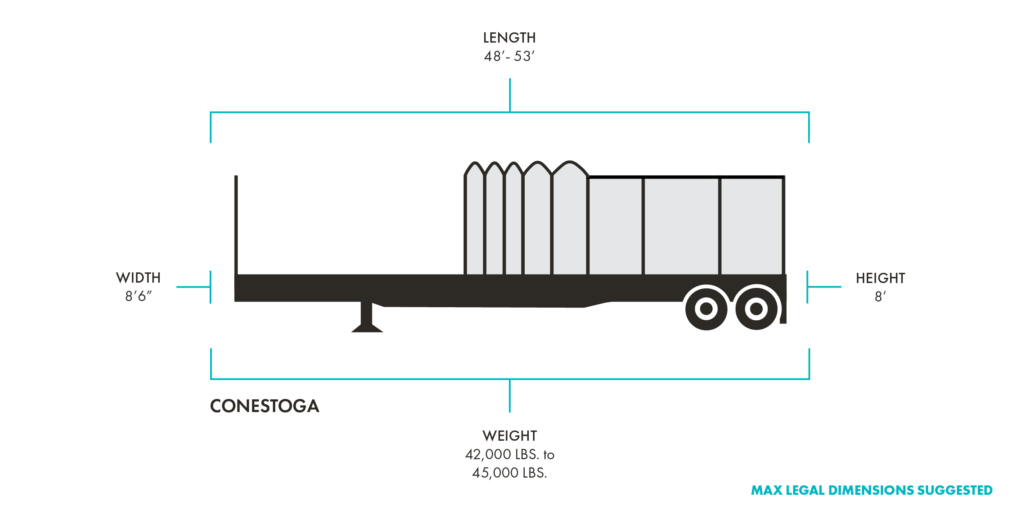
Maximum Legal Weight: 42,000 to 45,000 lbs.
Maximum Legal Cargo Length: 48 to 53 ft.
Maximum Legal Width: 8 ft. 6 in.
Maximum Legal Height: 8 ft.
One interesting fact about Conestoga trailers is that Conestoga is also a brand name for them. Conestogas are specialized, flatbed trailers that have a hard shell and rolling tarp system, which is great for freight that needs better protection from outside elements. These can be one of the most requested flatbed trailers due to their versatility. They can often be seen transporting freight like CNC machinery or helicopters.
Side Kit Flatbed Trailers
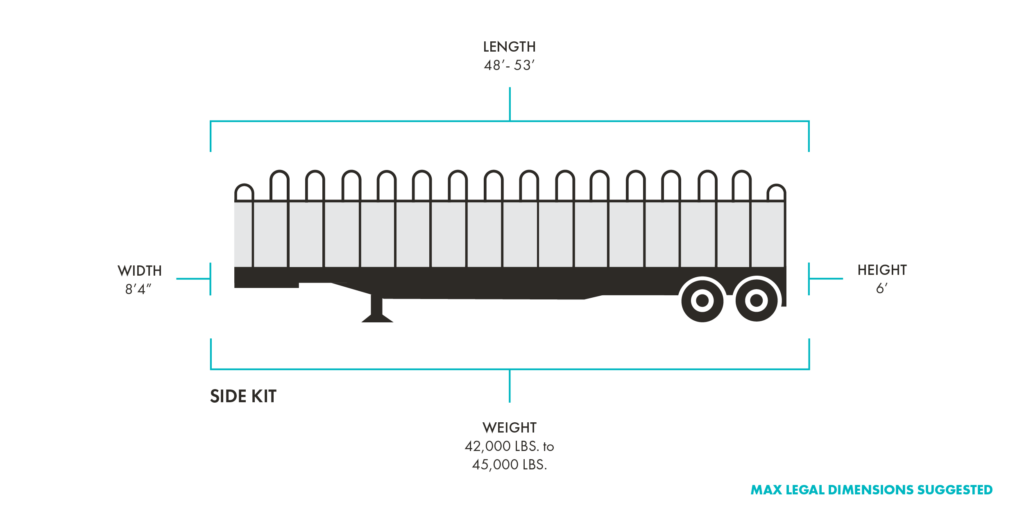
Maximum Legal Weight: 42,000 to 45,000 lbs.
Maximum Legal Cargo Length: 48 to 53 ft.
Maximum Legal Width: 8 ft. 4 in.
Maximum Legal Height: “technically” it’s 8 ft. 6 in. but because of sides, 6 ft. is more easily accomplished
Side kit trailers are like Conestogas in that they are flatbed trailers that offer more protection. These trailers have panels surrounding often made from plywood or fiberglass, allowing for tarping over the top. Side kits are great for freight that is not packaged or crated, like corn or watermelons.
Flatbed Trailer Tips
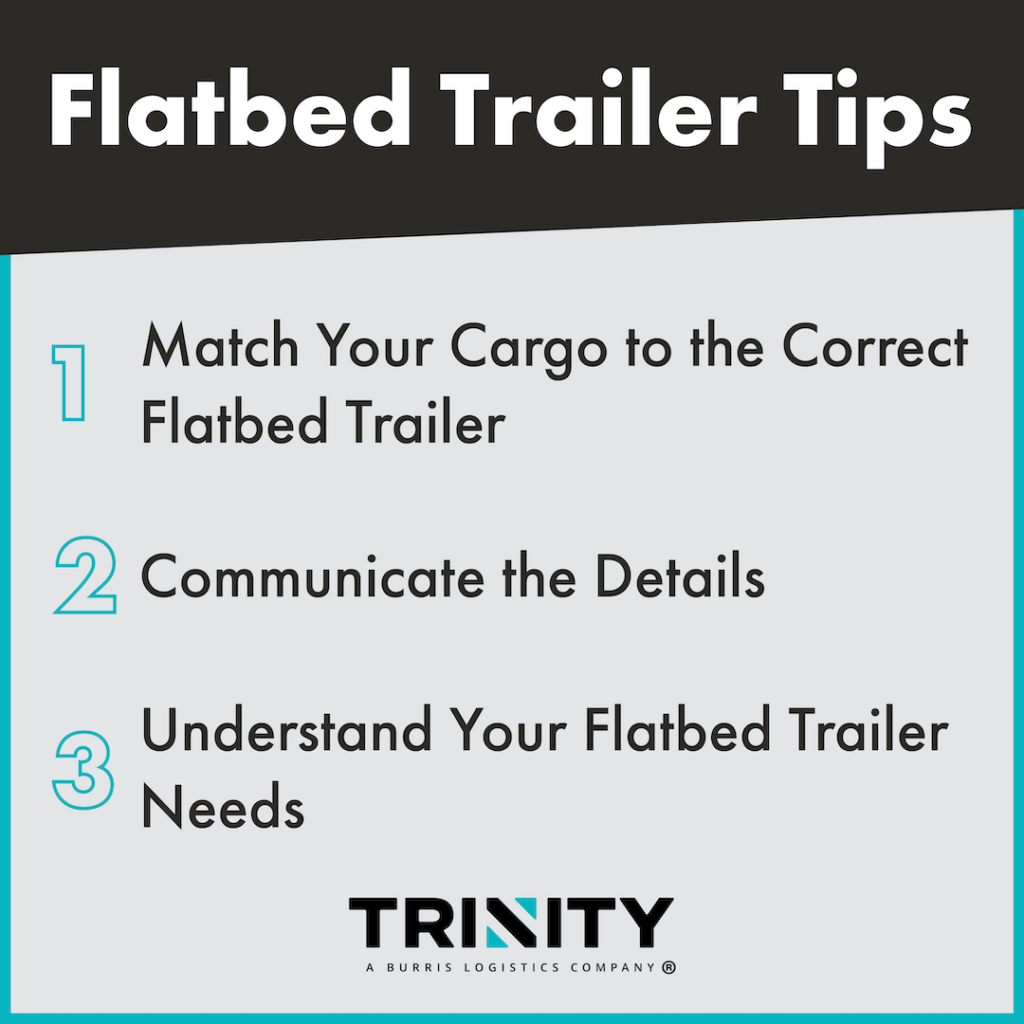
Match Your Cargo to the Correct Flatbed Trailer
It’s important to know your cargo and that you have the right flatbed trailer to transport it. If the wrong trailer pulls in and it can’t carry your freight, you’ve lost out on precious travel time. Additionally, having the correct trailer ensures safe transport.
Communicate the Details
Regardless of what kind of product you need to transport, a lack of detailed communication with your logistics provider is important to avoid confusion and setbacks. For a logistics provider to effectively support you with your flatbed shipping needs, you’ll need to share specific details such as:
- Dimensions of cargo (length, width, height)
- Cargo weight
- Type of commodity
- Does your freight have any sharp edges?
- Does it need tarped/element protection?
- Is your cargo multiple pieces or singular?
- Is your cargo loose or palletized?
Understanding Your Flatbed Trailer Needs
Understanding the different kinds of flatbed trailers there are helps you make more informed and cost-effective decisions. You’ll better know their limitations and whether they may be more costly and time-consuming to acquire. For example, by knowing that more specialized flatbed trailers like RGNs or Conestogas are tougher to obtain, you’ll know to give your logistics provider advanced notice for those shipments, giving you the benefit of a more successful relationship and potentially cheaper rates.
Access the Flatbed Trailers You Need with Trinity
Now that you know more about the different kinds of flatbed trailers, you’d think you would be set to manage flatbed shipping on your own. However, flatbed shipments aren’t always easy to facilitate. Depending on the type of freight, the flatbed trailer needed, and whether it’s an oversized shipment can all hinder and complicate things.
Flatbed shipping requires proper planning, effective communication, and access to carrier relationships with a variety of flatbed trailers to ensure supply chain success. Luckily for you, Trinity Logistics has over 45 years of experience and trusted relationships with expert flatbed carriers. Working with Trinity is like adding an extra person to your logistics team – one who’s able to take on the workload that comes with arranging flatbed shipments, finding the right flatbed trailer for the right cost, reducing your risk, ensuring the freight you need gets delivered right where it needs to on time and intact.
DISCOVER ALL THE BENEFITS OF SHIPPING FLATBED WITH TRINITY LOGISTICS

